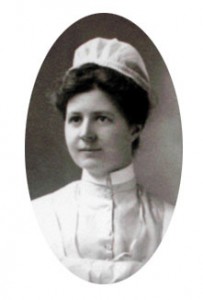An exhibit at the School of Nursing celebrates the life and work of an adventurous young nurse, whose travels in the early 1900s took her all over the world, to remote regions wracked by war and epidemics.
Story by Danielle Sweeney

Looking at the worn black leather albums, the letters, scrapbooks, and meticulously organized photographs, it is easy to see that School of Nursing alumna Vashti Bartlett ’06 wanted to chronicle her life: to remember her travels, her patients, and her observations as a nurse working all over the world in the early 20th century. She also wanted to be remembered. With the recent addition of the Vashti Bartlett Papers to the Johns Hopkins Nursing Historical Collection, no one at Johns Hopkins is likely to forget who she was anytime soon.
Bartlett’s nephew donated her papers to the School of Nursing in 1969, shortly after her death. The collection covers more than six decades, from 1906 to 1969; however a large portion is devoted to Bartlett’s years as a nurse (1906–1929) in Newfoundland, France, Belgium, Siberia, Haiti, and the United States.
The papers were stored in the Nightingale Room of the Welch Library, and, after the nursing school was closed in 1973 (it re-opened in 1984 as part of Johns Hopkins University), they were unintentionally forgotten. They remained in the library for 30 years until they were rediscovered in 2000, after a Nursing Archives Advisory Committee meeting, says Nancy McCall, an archivist at the Alan Mason Chesney Medical Archives. “We didn’t know who Vashti Bartlett was until we uncovered her life on a shelf. She was a fascinating woman.”
Bartlett’s papers, which include numerous letters, notebooks (from her days at Hopkins), colored postcards, drawings and paintings (gifts from her patients), photographic negatives, ephemera, and some small artifacts, are organized methodically, with a nurse’s attention to detail and a keen eye toward history. “Like a typical Hopkins nurse, she was very organized,” says McCall.
Bartlett was a compiler — she saved not only the letters she received but made carbon copies of those she sent as well. “This collection is unique in its completeness,” says Phoebe Evans Letocha, coordinator of processing and research in the archives. “It’s a total picture of her life, not just parts of it.”
Bartlett came from a prominent, affluent Baltimore family. Her paternal grandfather was George Bartlett, director of the B&O Railroad. After graduating from Hopkins School of Nursing in 1906, Bartlett spent two years working at Hopkins Hospital before, like many young nurses and doctors of her time, she embarked on a foreign service career.
In 1908 she joined Dr. Wilfred Grenfell’s Royal National Mission to Deep Sea Fishermen in Newfoundland and served as chief nurse at the mission’s hospital in St. Anthony. The mission was the only source of health care for the native population of fishermen and their families — an impoverished and semi-literate community that was plagued by alcoholism. Bartlett was impressed by what Grenfell had managed to accomplish in the 30 years he had worked there. He had “effected a revolution so complete that it seems like a miracle,” she wrote, noting that he had built sawmills, orphanages, hospitals, workshops, and launches attached to the land hospitals to help transport patients more easily, since there were no roads.
Bartlett joined the Red Cross in March 1915, and she sailed to France on a Red Cross “Mercy Ship” destined for the city of Pau, at the foot of the Pyrenees mountains, to care for casualties fighting at the front during World War I. She made copious journal entries about her experiences and wrote many letters. Some of her observations were strictly professional: “Pau has many hospitals. Ours was located at the Palais d’Hiver…,” she wrote. “When I arrived I found 18 nurses and six doctors. There are 176 beds.”
But others were the thoughts of a woman bearing witness to the suffering of war: “…We turned with wonder and admiration to these men lying shattered and in pain. Many of them without news from home — not a few facing the future hopelessly crippled, bodily and financially.”
Francis Milligan, MD, a retired Hopkins gastroenterologist and archives volunteer who helped process the Bartlett Papers, was struck by Bartlett’s objectivity. “She recorded her observations in a very honest fashion. There is almost no rancor in her correspondence,” he says. “And her focus is not on herself, but on the places and events around her.”
In Pau, Bartlett described treating the wounded so they could return to the front: “If they are not so badly wounded we bring them back and heal them and send them forward again to the firing line that they may go through this agony once more — but such is the…bravery of these ordinary French men.”
In October 1915, the Red Cross transferred Bartlett to Belgium, where she directed nursing services until May 1916, when she returned to work in the Red Cross’ Washington, D.C., headquarters. Two years later, in 1918, she left the U.S. again for a mission to Vladivostok, Siberia, where she cared for refugees who were fleeing the fighting of the Russian Revolution. Shortly after beginning that assignment, Bartlett was transferred to Manchuria, to treat an outbreak of cholera.
Bartlett described the scene and the suffering: “At first, the death rate was from two to three hundred daily…[The] cause of death is due to the fact that so much of the fluids of the body are [given] off in the almost constant flow of vomiting and stools, that the blood cannot flow for lack of [fluids].” But the Red Cross team soon introduced intravenous infusions of glucose and electrolytes, which cut the death rate by 50 percent.
Bartlett eventually returned to Vladivostok — long enough to introduce a course for Russian women in home hygiene and caring for the sick — but the Red Cross soon closed its Siberian mission because the Bolsheviks had advanced upon the city.
Her final Red Cross mission was to Haiti in 1921. The plan was for Bartlett to direct a Navy Nurse Corps nursing school at the City General Hospital in Port-au-Prince. Upon her arrival, disfiguring disease was endemic. “Syphilis is everywhere and the cases are so advanced that often the fingers, toes, hand or foot will be gone. We have two cases of leprosy, and one woman with abdominal glands so infected that they have ruptured the skin in five places,” she wrote. Then smallpox broke out, and the Red Cross’ services were needed for infection control.
Bartlett was working with 14 nurses and more than 600 patients, but managed to contain the spread of the epidemic and eventually resumed teaching the local women. In January of 1921, she wrote about their graduation: “We gave three of the nurses [hypodermic needles] in appreciation of the work they did in the smallpox compound. They were the ones who offered to nurse the patients before their own vaccinations had taken… We were glad to surprise them with a little address of thanks.”
In 1921, she resigned from the Red Cross to direct a nursing school at an Indian Reservation in Oklahoma. She retired from nursing eight years later and returned to live with her family, who had homes in Maryland and Florida. Bartlett never married and there is very little information in her papers documenting her post-retirement years.
Last fall, the School of Nursing and the archives staff mounted an exhibit, “Vashti Bartlett: A Hopkins Nurse’s Global Mission,” which is on display on the first floor of the School of Nursing. An electronic version of the exhibit, supplemented with additional digitized photos and images, is on the Web at http://www.medicalarchives.jhmi.edu/vbartlett/index.htm. Both exhibits are funded in part by the Nurses’ Alumni Association.
Danielle Sweeney writes from Baltimore.
 You’re Welcome
You’re Welcome Nursing Named Most Trusted Profession for 22nd Consecutive Year
Nursing Named Most Trusted Profession for 22nd Consecutive Year Best of On The Pulse 2023
Best of On The Pulse 2023 From the Dean: Here & Now
From the Dean: Here & Now The Learning Collaborative: ‘I Think I Can, I Think I Can …’
The Learning Collaborative: ‘I Think I Can, I Think I Can …’







